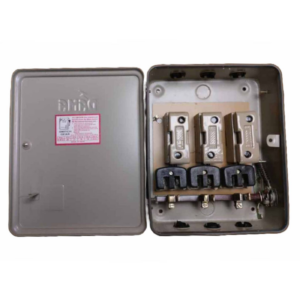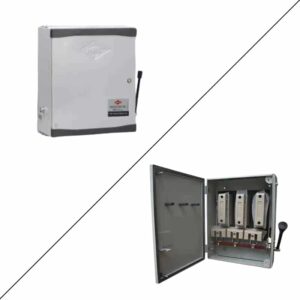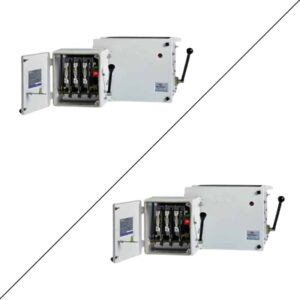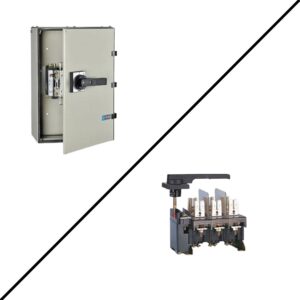Main Switch
Current or power on entering the house passes through the main fuse and the meter. Thereafter comes the main switch and the main fuses of the house, then various circuits which are parallel to each other.
Switch
A switch is electrical equipment that helps discontinue, disconnect or continue, connect the flow of electrical energy in a circuit. An electrical switch would either allow or deny the flow of current due to its binary nature.
Main Switch Box
The main switch also known as the master switch makes or breaks the flow of current through all the circuits in your house, building, factory, etc. In a circuit breaker box, the first and biggest switch is usually the main switch (about 60 to 100 amps) followed by a row of smaller breakers (maybe 10 or 15 or 20 amps each) that go to each area of the house, like kitchen, or bathroom, or living room lights, or living room sockets hence called main circuit breaker.
If you’re aware of an electrical panel then you might have realized the presence of various circuit breakers connected to different facilities and branches adjacent to each other.
For convenience, these circuit breakers or switches are either numbered or labeled. In either case, it’s easy to identify the Main Switch or Main Circuit Breaker since it’s situated either above/below the row/rows or switches also called circuit breakers, at the side or at the very center.
Low voltage circuit breakers are used for residential purposes, medium voltage breakers for buildings like offices or factories (depending on the scale), and high voltage circuits for bigger facilities or areas may be a city.
Purpose
The purpose of the main circuit breaker is to provide security and safety in a reliable manner against hazardous events that might occur, thanks to electric faults.
The branch circuit breakers have a lower capacity to bear fluctuations, hence there is a need for the main circuit breaker to handle the load.
The main switch trips off shunning power supply to the subsidiary circuits connected to varied branches averting spark, fire, and electric arc in case of surplus supply safeguarding the individual working on the circuit from shock and/or death.
Operation
The circuit breakers or electrical switches are designed and developed specifically for preventing any hazardous occurrences. When closed, the circuit breakers allow the flow of current, and when this current exceeds the limit the breaker trips preventing overflow of current.
The low-voltage circuit breakers in residential electrical panels bring 240V of power through two wires each with the capacity of 120V. They use the stored energy in the spring to throw the switch and separate contact with the circuit. This enables you to manually cut off and reset the power delivery with the flip of a switch.
Working
• The branch circuit breakers are subsidiary to the main circuit breaker.
• The power flows through the main circuit breaker to the branch circuit breakers, which successively supply this energy to the concerned branches or areas for instance in the kitchen, garage, and so on.
• The main circuit breaker is built conforming to the safety standards with a specified amount of amperage.
• When the current passing through this main circuit breaker exceeds its specified limit the circuit is automatically severed when the breaker trips, restricting the flow of current.
• This simultaneously restricts the flow of current to the branch circuit breakers killing the flow of electricity for the entire facility.
• Usually this problem never occurs since the branch circuit breakers shut off power to individual circuits in case of overload.
The reason that these circuit breakers could trip is power surges, problems in the system, more power demand leading to overload, etc.
Manual or Voluntary Shut-off
If the power supply needs to be cut off for reasons such as repair or maintenance the following steps should be taken:
• Firstly take precautions while working with electrical equipment that is recommended.
• The main breaker which is the source of electricity in the facility should not be touched immediately in order to cut off the power supply.
• The branch circuit breakers should be carefully and individually shut off in order to prevent any mishap.
• After affirming that the individual branch circuit breakers have been carefully shut off the main circuit breaker should be turned off.
• When it comes to restoring the supply of electricity the same process should be followed in reverse.
• This implies that after flipping ON the main circuit breaker, individual circuit breakers should be flipped ON one at a time to prevent the sudden flow of current.
Precaution
Although the main circuit breaker trips once in a blue moon, if this happens often it will depreciate the capacity of the main breaker, lowering its amperage capacity. This can be rectified by simple mechanical tools and skills.
Best Circuit Breakers Brands:
2. Havells
3. Siemens
4. ABB
5. L & T
6. Legrand
7. Anchor
Important Characteristics to be Studied Before Buying
• Voltage Rating
• Amperage Capacity
• Breaking Capacity
• Operating Conditions
Conclusion
Although the main breaker seldom trips you can never be fully sure of the surges in electricity. Since you’ve invested your hard-earned money on appliances it’s your responsibility to protect them from harm that are avoidable.
Also these devices are necessary not only for the safety of products but also life.
The outputs of the main switch are connected to the PDU. From here, one of the phases will power the power supplies and goes into the terminal block as well.
Power supply input maybe 100 to 240 volts AC. These power supplies convert the AC signal to a DC voltage output, 24 volts in one case, and 12 volts in the other. This DC power supply can then be used for the devices of the control panel, or for the devices on the ground too!
The 3-phase power supply passing through the terminal block can be used to power devices that operate with a 3-phase power supply.
When we put the main switch to the ‘0’ position, the incoming 3 phase supply power will be disconnected, and that shuts down the whole control panel, including all of the devices that work with DC power, and also the devices that work with 3 phase power.
 (+91) 7439 448 917
(+91) 7439 448 917 Cash on Delivery Available
Cash on Delivery Available



 Circuit Breakers
Circuit Breakers Power Distribution
Power Distribution Modular Switchboard
Modular Switchboard Wires & Cables
Wires & Cables













































